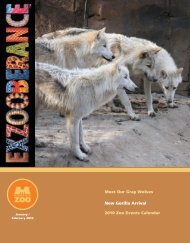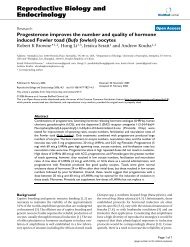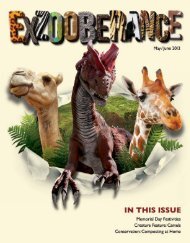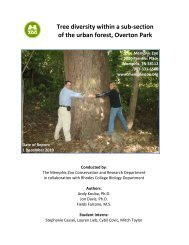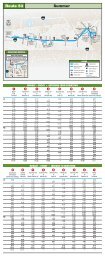Giant Panda Teacher Packet - Memphis Zoo
Giant Panda Teacher Packet - Memphis Zoo
Giant Panda Teacher Packet - Memphis Zoo
- No tags were found...
You also want an ePaper? Increase the reach of your titles
YUMPU automatically turns print PDFs into web optimized ePapers that Google loves.
Bamboo CornersGoal: Students will understand how the life cycle of bamboo affects the giant panda.Behavioral objectives:1) Students will understand that there are different types of bamboo that giant pandas eat.2) Students will understand how the life cycle of bamboo and habitat fragmentation relate to oneanother.Curriculum Standard Correlations:Grade 3• 2.3 Examine interrelationships among plants, animals, and their environment.Grade 4• 2.1 Investigate the relationships among organisms in a specific ecosystem.• 4.3 Investigate the life cycles of different organisms.Grade 5• 2.1 Investigate the relationships among organisms in a specific ecosystem.• 4.3 Investigate the life cycles of different organisms.Time:45 minutesBackground Information:In the wild, giant pandas can be found in three provinces of China: Sichuan, Shaanxi and Gansu. A Chineseprovince is similar to a state in the United States of America. <strong>Giant</strong> pandas can be found in six mountainranges located in these three provinces. The names of these mountain ranges are the Min Mountains,Qionglai Mountains, Qinling Mountains, Liang Mountains, Daxiang and Xiaoxiang Mountains. Themajority of these mountain ranges are located in the province of Sichuan. The Min or Minshan Mountainsextend into Gansu and the Qinling Mountains are outside of Sichuan in the province of Shaanxi. The WorldWildlife Fund and the Ministry of Forestry estimated in 1988 that there were about 1,000 giant pandas livingthroughout these mountain ranges.The giant pandas live in the bamboo forests of these mountain ranges. The bamboo growing in these forestsmakes up 99% of the giant panda’s diet. The other 1% may consist of fish, mushrooms and small rodents.The giant panda has several adaptations for its bamboo diet. It has an enlarged and extended wrist bone onthe inside of each front paw. This wrist bone helps the giant panda to hold onto a bamboo stalk as it iseating. It has thick, strong muscles attached to its massive jawbone and wide, flattened back teeth that worktogether to help crush and grind the bamboo.In order to survive, a giant panda must eat 20-40 pounds of bamboo a day depending on its size. The giantpanda requires this much bamboo for a couple of reasons. One reason is bamboo is low in nutrients. Theother reason is that the stomach of a giant panda is designed for a carnivore so it does not digest plantmaterial very effectively. It only digests on average about 17% of the bamboo it eats. The indigestible partof the bamboo passes through its short digestive tract in less than eight hours. The giant panda usually hasno problem consuming the 20-40 pounds of bamboo it needs because bamboo is usually plentiful andavailable all year round in the six mountain ranges where giant pandas live.31



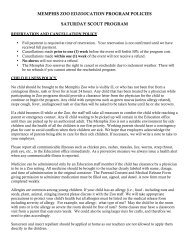

![Download the Teton Trek Presskit [PDF] - Memphis Zoo](https://img.yumpu.com/50103993/1/190x245/download-the-teton-trek-presskit-pdf-memphis-zoo.jpg?quality=85)

